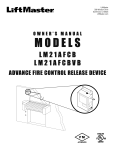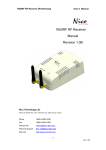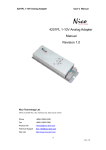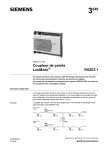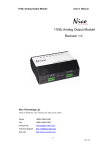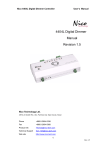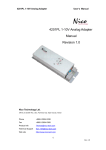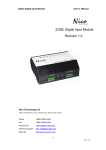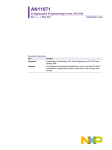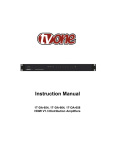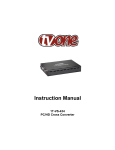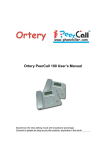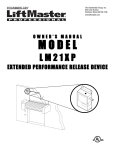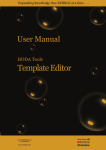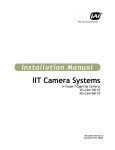Download RF Receiver 7600SR
Transcript
7600RF RF Receiver User’s Manual 7600RF RF Receiver Manual Revision 2.1E Nico Technology Ltd. 24F,No.37,SanMin Rd, 2.Sec, PanChiao City, Taipei County, Taiwan Phone +886-2-2954-5338 Fax +886-2-2954-5308 Product Info [email protected] Technical Support [email protected] Web site http://www.nico-tech.com 1 Rev.2.1E 7600RF RF Receiver User’s Manual This Manual This manual provides any required information for installation, configuration and operation of the 7600RF RF Receiver. It exclusively treats the handling of this device. It neither describes the LonWorks technology by Echelon nor the LonMark profile implemented in detail. More specific information concerning these subjects can be found in the documentation of Echelon (www.echelon.com) and the LonMark Interoperability Association (www.lonmark.org). The first part of this manual provides a survey about the device and its installation in chapters 1 to 3. The 2nd part describes the implemented application for lighting control and its configuration possibilities. Chapter 4 contains a description of the firmware interface while chapter 5 describes the implemented LonMark Objects in detail providing an outlook of the individual objects, their tasks and their relevant configuration parameters. Chapter 6 explains the basics required to connect the objects to each other. This manual is relevant for all variants of the 7600RF RF Receiver where applications for lighting and switch control are implemented. This documentation is subject to modification at any time without prior advice. Nico does not take over any responsibility for mistakes or inaccuracies in this documentation and eventually occurring consequences. In any case Nico as well as its representatives and staff are not reliable for eventual defaults, damages caused indirectly or during use, occurring due to the use or non-usability of the software or the accompanying documentation. Nico is a registered trademark of Nico Technology Ltd. Echelon, LON, LonMark, LonWorks and Neuron are registered trademarks of Echelon Corporation. Other name may be registered trade marks of the respective companies. 2 Rev.2.1E 7600RF RF Receiver User’s Manual Contents Contents .........................................................................................................................3 2 Product Information ...............................................................................................4 3 2.1 Functional Elements...................................................................................4 Installation..............................................................................................................4 4 3.1 Warnings ....................................................................................................5 3.2 Mounting....................................................................................................6 3.3 Connections................................................................................................6 3.4 Software Installation ..................................................................................7 Device Description.................................................................................................8 5 4.1 Hardware Survey .......................................................................................8 4.2 Operation and Display Elements ...............................................................8 4.3 Connection Pin Assignment.......................................................................8 4.4 EMC.........................................................................................................10 4.5 Technical Specifications ..........................................................................10 4.6 Dimensions ..............................................................................................11 Application Software for ECOBINO...................................................................12 6 5.2 Interoperable Interface .............................................................................13 System Objects.....................................................................................................14 6.1 Node Object .............................................................................................14 6.2 Sensor Object ...........................................................................................15 6.3 Default CP Value of Sensor Object..........................................................17 6.4 Battery life measure .................................................................................18 6.5 DIP Switch Setting...................................................................................18 6.5.1 DIP Switch for ON 7xxxRF Sensor devices........................................18 6.5.2 Wireless network Channel ID Setting..................................................19 7 Wireless Sensor ID Setting ..................................................................................19 8 Wireless Frequency scope and PN code ..............................................................20 PN code is for separate channel which is use same wireless frequency channel. .......20 3 Rev.2.1E 7600RF RF Receiver User’s Manual 2 Product Information 2.1 Functional Elements Figure 1.1 7600RF RF Receiver No Description 1 Wireless antenna 2 Service pin button 3 Service LED indicator 4 DIP switch for wireless channel ID setting 5 LonWorks network connector 6 Power supply. 12~24VDC 2.2 Variants and Identifications 2.3 Scope of Delivery 3 Installation This chapter first describes the installation of the device; the installation of the configuration software is described in section 2.4. 4 Rev.2.1E 7600RF RF Receiver 3.1 User’s Manual Warnings Attention The device must be installed in compliance with the relevant DIN/VDE regulations or the relevant national standards. The connection to the supply voltage must be performed in accordance with VDE 0100 and VDE 0160 or the relevant national standards. Installation should perform by qualified and technical experienced personnel only. CAUTION At the connections of the LonWorks network 1 – 4 (Fig. 1.1, terminals 5) and the power supply (terminals 6) 12~24VDC main voltage with load guard band is accessible. The installation of the unit therefore has to be effected in a switch cabinet or behind a respective cover. 5 Rev.2.1E 7600RF RF Receiver 3.2 User’s Manual Mounting 3.3 Connections The 7600RF has to be connected to a 12 ~24VDC power supply and to the LonWorks network. According to the respective application peripheral equipment has to be connected to outputs. 6 Rev.2.1E 7600RF RF Receiver User’s Manual Attention Before connecting peripheral equipment the power supply device has to be switched off. The connection is effected by means of the included screw less terminals. Clamping range of the screw terminals: - Power supply connections (5.08mm grid, terminals 6): 0.2 – 2.5mm The pin assignment of the connections is described in chapter 3.1, also containing wiring details. Voltage The 12~24 Volt DC connections are through connected in order to achieve easy installation. LonWorks Network The connection to the LonWorks network is made by means of power line channels. Attention The 7600RF RF Receiver power supply recommend use 24VDC power supply. 3.4 Software Installation The configuration software of the 7600RF RF Receiver has to be installed by starting the program Setup.exe on the data carrier provided. It suns under Windows 9x/2000 and NT. Download url: http://www.nico-tech.com/download 7 Rev.2.1E 7600RF RF Receiver User’s Manual 4 Device Description The 7600RF RF Receiver for LonWorks network in automation. Its peripheral scope has been specially designed for the use as valve controller for device spreading control of applications such as valve control or lighting control. 4.1 Hardware Survey The 7600RF RF Receiver disposes of one LonWorks circuit for each. 4.2 Operation and Display Elements The 7600RF RF Receiver is fitted with a service button accessible via a small gap on the front panel (see Figure. 1.1, 8). Activation of the buttons generates a service-pin message transmitted via the LonWorks network. The processor status as well as the service-pin status are displayed by the service LED (figure. 1.1,A), which is on while the service button is activated. 4.3 Connection Pin Assignment The following tables show the connector pin assignment of the individual connectors. Connections the 1 marking cf. Figure. 1.1 On previously page. In each clamp block pin 1 is situated on the left. For further wiring information see figure 3.1. LonWorks Network Connection The double-core bus line can be connection either to Net . No polarity has to be considered by connecting the LonWorks network. 8 Rev.2.1E 7600RF RF Receiver User’s Manual Figure 3.1 Connector pin assignment LonWorks network 9 Rev.2.1E 7600RF RF Receiver User’s Manual 4.4 EMC The 7600RF RF Receiver is a CE certified device according to the regulation 89/336/EEC for electron magnetic compatibility, modified by 92/31/EEC”. Concerning the emission it fulfills classification B (living area) according to EN 55022A/B, EN 55011 A/B and EN 50081-1/2 and, concerning the interference sensibility, classification A (industrial area) according to EN 50082-2. 4.5 Technical Specifications CPU Echelon Neuron 3150,10MHz Memory 64Kbytes Flash memory, 512Bytes EEPROM,2Kbytes SRAM,8Kbyte external SRAM LonWorks Transceiver FT-X1 Power supply 12~24VDC(24VDC is recommend) Power consumption 1.5w Connection M2.5 screw (Pitch:3.5mm) Temperature Operation Storage 0 ~ +50 -20 ~ +70 Admitted relative humidity 10 ~ 90%, non condensing Dimensions 60 x 94 x 30 mm, Mounting Wall mounting Display & Operation Service-pin and Reset LED indicator and button Max. connections 8 wireless sensor devices Max trans len 10 Meters Table 3.1 Technical Specification 10 Rev.2.1E 7600RF RF Receiver 4.6 User’s Manual Dimensions Figure 3.5 Device dimensions without plug-screw clamps 11 Rev.2.1E 7600RF RF Receiver User’s Manual 5 Application Software for ECOBINO On the 7600RF RF Receiver an application for energy saving control is implemented, making output functionality as well as switch control functions available. Therefore the relevant LonMark profiles stated in Table 4.1 are implemented. The use of network variables (NV) compiles with the LonMark standard, no customized network variables are used. SCPT’s are used for parameterization by applying the read/write-memory method. Title Present Version Identification LonMark Application Layer Interoperability Guidelines V3.1 078-0120-01D The SNVT Master List and Programmer’s Guide V 8.0 The SCPT Master List V 8.0 Sensor Object Table 4.1 Referring document about LonMark profiles 5.1 System Scope The 7600RF RF Receiver is equipped between Wireless and LonWorks channels. Each Wireless network allows then connection eight wireless sensors. Sensor Object according to LonMark Standard can be assigned to these output and configured. Furthermore the 7600RF RF Receiver can act as constant sensor controller. The sensor received value from wireless sensor generated by the internal via an output network variable. The 7600RF RF Receiver is equipped with one LonWorks communication circuit to connect LonWorks network. 12 Rev.2.1E 7600RF RF Receiver User’s Manual 5.2 Interoperable Interface The LonMark profile 1040,1050,1010 are realized in the 7600RF RF Receiver. As some customized NVs are used, the network interface remains standardized, clear and especially it is interoperable. That means, the 7600RF RF Receiver can be used in connection with network components by other manufactures. The following table contains a survey of the network variables defining the 7600RF RF Receiver network interface and their assignment. NV Name Type Allocated Object nvo_lux_val SNVT_lux Sensor Object nvo_RH_val SNVT_lev_percent Sensor Object nvo_temp_val SNVT_temp_p Sensor Object Table 4.4 Allocation of NVs and LonMark objects Under the order code 7600RF a data carrier containing the interface describing files ECOBINO_WG_P2.XIF and the applications ECOBINO_WG_P2.APB is provided free of charge at simultaneous purchase of ECOBINO system. The XIF-file is necessary for integration with LonMaker for Windows or any other LonWorks network management tool. 13 Rev.2.1E 7600RF RF Receiver User’s Manual 6 System Objects This chapter describes the LonMark objects implemented in the 7600RF RF Receiver. For each it states the network variable les used, special configuration properties, general object properties, response during modification of the configuration and after a reset, and, if available, further object properties. 6.1 Node Object The functionality of the node object is defined in the Application Layer Guidelines of LonMark Interoperability Association (www.lonmark.org). Network Variables NV Name NV Type Comment nviRequest SNVT_obj_request Status request nvoStatus SNVT_obj_status Status response nvoAlarm SNVT_alarm Alarm generating nvoFileDirectory SNVT_address Address of file for parameterization 14 Rev.2.1E 7600RF RF Receiver 6.2 User’s Manual Sensor Object Network Variables NV Name NV Type Comment nvo_ave_lux SNVT_lux Average value of Lux Valid range:1~65535 nvo_battery_life SNVT_lev_percent Battery life information Valid ragne:0~100% (0,10,25,40,55,70,85,100%) nvo_lux_val SNVT_lux Lux value nvo_RH_val SNVT_lev_percent Humidity value Valid range:0~100 nvo_sensor_alarm UNVT_sensor_alarm Sensor Alarm nvo_temp_val SNVT_temp_p Temperature value Valid range:-50~70 Configuration Properties CP Name Comment error_count Define how many “No data” error occurs then send the “Sensor Dead” alarm Default value:6 Valid range: 1~100 When “No data” received within 30 second then error_count +1. When current error count equal then error_count cp value and then send the “Sensor Dead” 15 Rev.2.1E 7600RF RF Receiver User’s Manual alarm. When any signal is received, reset the error_count invalid_count Define how many “Invalid data” error occurs then send the “Invalid data” alarm Default value: 6 Valid range: 1~100 When “Invalid” or “No data” errors received within 30 secs, then invald_count+1. When “valid data” is received, reset invalid count. When current invalid count equals to invalid count cp value and then send the “Invalid data” alarm of the sensor. buffer_size Define totally of buffer_size. (max: 100) Default value:100 Valid scope: 1~100 average_calculate_time For average lux values calculate.(Minute) default value: 10.( 30 samples) Every 20 seconds collect a sample from nvolux_value Valid scope: 10~255 If samples of buffer not enough then sum all the value of current sample to division number of sample. Ex. Current number of samples: 6 (Value_1 + Value_2 + Value_3 + Value_4 + Value_5 + Value_6) / 6 = nvo_ave_lux modification.mod0 Ref. Lux Modification(must change to 1) Valid range: -1638.4 ~ 1638.3 modification.mod1 Ref. Lux Modification(must change to 1) Valid range: IEEE 754 modification.mod2 Ref. Lux Modification Valid range: IEEE 754 modification.dis Lux modification’s distinction Valid range: 0 ~ 65535 power_up_value Default output value for power up sensor gateway. Before receive first time value of 16 Rev.2.1E 7600RF RF Receiver User’s Manual sensor. Valid range: -32768 ~ 32767 [Attention] Do not use copy or dump function within LM4W when configure functional block. That can get automatic generate a correct default value, invalid high value, invalid low value, alarm high value and alarm low value. dead_state_value Output value of sensor dead alarm occurs. Valid range: -32768 ~ 32767 invalid_state_value Output value of sensor invalid data alarm occurs. Valid range: -32768 ~ 32767 valid_high_limit Define valid value of scope. (Max) Valid range: -32768 ~ 32767 value_low_limit Define valid value of scope. (Min) Valid range: -32768 ~ 32767 alarm_high_limit Define alarm value of scope (Max) Valid range: -32768 ~ 32767 alarm_low_limit Define alarm value of scope (Min) Valid range: -32768 ~ 32767 6.3 Default CP Value of Sensor Object CP Name Lux Room Temp Room Humidity Freezer error_count 6 6 6 6 invalid_count 6 6 6 6 buffer_size 100 100 100 100 average_calculate_time 10 10 10 10 modification.mod0 0 0 0 0 modification.mod1 1 1 1 1 modification.mod2 0 0 0 0 modification.dis 0 0 0 0 power_up_value 1 20 50 0 dead_state_value 0 0 0 0 invalid_state_value 0 0 0 0 valid_high_limit 30000 100 99 100 value_low_limit 0 0 0 -40 alarm_high_limit 30000 100 95 25 alarm_low_limit 1 0 0 -25 17 Rev.2.1E 7600RF RF Receiver 6.4 User’s Manual Battery life measure Battery Life Detect voltage 0% <3 10% 3 ~ 3.25 25% 3.25 ~ 3.5 40% 3.5 ~ 3.75 55% 3.7 5~ 4 70% 4 ~ 4.25 85% 4.25 ~ 4.5 100% >4.5 6.5 DIP Switch Setting DIP Switch overview there are two kinds of DIP Switch for 7600RF Receiver and 7xxxRF serial Sensors. On 7600RF Receiver have 5 DIP switch for configure setting Wireless network ID. On 7xxxRF serial Sensors have 5 DIP switch for configure setting Wireless network ID (NET ID) and Sensor devices (Sensor ID) In order to wireless devices can working correct, you have to configure correct NET ID on Sensor devices and 7600RF devices. 6.5.1 DIP Switch for ON 7xxxRF Sensor devices The DIP Switch is setting by binary and each 7600RF RF Receiver have to configure as unique “Network ID”. The valid channel id was between 0 and 15. Figure 6.1 Identify DIP Switch for 7600RF RF Receiver Wireless network ID 18 Rev.2.1E 7600RF RF Receiver User’s Manual 6.5.2 Wireless network Channel ID Setting Figure 6.2 DIP Switch for Wireless network ID on 7600RF RF Receiver 7 Wireless Sensor ID Setting Figure 7.1 DIP Switch for 7002RF Temperature & Humidify Sensor ID Figure 7.2 DIP Switch for 7001RF Freezer Temperature Sensor ID 19 Rev.2.1E 7600RF RF Receiver User’s Manual Figure 7.3 DIP Switch for 7200RF Lux Sensor ID 8 Wireless Frequency scope and PN code Channel ID Primary Channel Second Channel PN Code 0 2400 MHz 2440 MHz 0x83,0xF7,0xA8,0x2D,0x7A,0x44,0x64,0xD3 1 2404 MHz 2444 MHz 0x40,0xBA,0x97,0xD5,0x86,0x4F,0xCC,0xD1 2 2409 MHz 2449 MHz 0x3F,0x2C,0x4E,0xAA,0x71,0x48,0x7A,0xC9 3 2414 MHz 2454 MHz 0x17,0xFF,0x9E,0x21,0x36,0x90,0xC7,0x82 4 2419 MHz 2459 MHz 0xA6,0x46,0xB5,0x9A,0x3A,0x30,0xB6,0xAD 5 2424 MHz 2464 MHz 0xBC,0x5D,0x9A,0x5B,0xEE,0x7F,0x42,0xEB 6 2429 MHz 2469 MHz 0x24,0xF5,0xDD,0xF8,0x7A,0x77,0x74,0xE7 7 2434 MHz 2474 MHz 0x3D,0x70,0x7C,0x94,0xDC,0x84,0xAD,0x95 8 2400 MHz 2440 MHz 0x40,0xBA,0x97,0xD5,0x86,0x4F,0xCC,0xD1 9 2404 MHz 2444 MHz 0x3F,0x2C,0x4E,0xAA,0x71,0x48,0x7A,0xC9 10 2409 MHz 2449 MHz 0x17,0xFF,0x9E,0x21,0x36,0x90,0xC7,0x82 11 2414 MHz 2454 MHz 0xA6,0x46,0xB5,0x9A,0x3A,0x30,0xB6,0xAD 12 2419 MHz 2459 MHz 0xBC,0x5D,0x9A,0x5B,0xEE,0x7F,0x42,0xEB 13 2424 MHz 2464 MHz 0x24,0xF5,0xDD,0xF8,0x7A,0x77,0x74,0xE7 14 2429 MHz 2469 MHz 0x3D,0x70,0x7C,0x94,0xDC,0x84,0xAD,0x95 15 2434 MHz 2474 MHz 0x1E,0x6A,0xF0,0x37,0x52,0x7B,0x11,0xD4 PN code is for separate channel which is use same wireless frequency channel. Channel 0~7 and 8~15 were use same radio frequency, but there have different PN code for separate channel identify even there are use same frequency for wireless transmission. Only correct frequency setting and PN code then wireless sensor could be communication with receiver. 20 Rev.2.1E




















